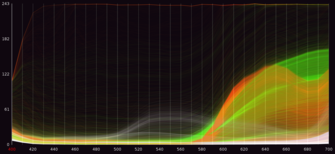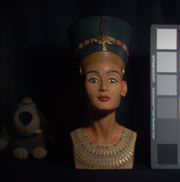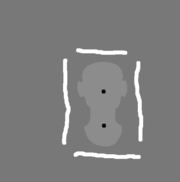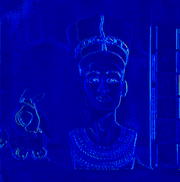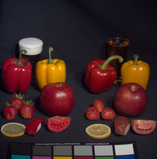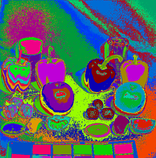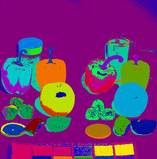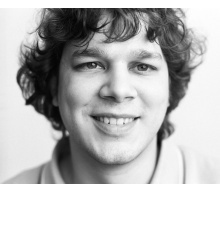
Dipl.-Inf. Johannes Jordan
Alumnus of the Pattern Recognition Lab of the Friedrich-Alexander-Universität Erlangen-Nürnberg
Multispectral Image Segmentation
A vital analysis tool within our framework is segmentation. With a good segmentation, the user can easily find specific regions in the image, reveal charasteristics of these regions, and contrast them to others based on their content. As an example, in the picture with fake and real peppers to the right, their difference is easily revealed just by automatically segmenting both and looking at their spectral distribution.
To bring segmentation to our framework, we investigate clustering and segmentation algorithms that are popular in computer vision and find adaptations for the multispectral domain.
In an interactive analysis framework, input from the user is an important prior to the segmentation tasks. As the user explores the multispectral data step-by-step, she may want to compare the spectra of specific objects in the scene or examine reflectance properties of a certain area in detail. Such a segmentation replaces tedious manual labeling of this area, but was previously unavailable for multispectral or hyperspectral images.
In recent years, graph-based methods have had a significant impact on image segmentation. They are especially noteworthy for supervised segmentation, where the user provides task-specific foreground and background seeds. In our work we adapted the graph-cut and power watershed algorithms to the multispectral domain. For this, we define new edge weights in the graph based on spectral dissimilarity measures. We also introduce a new data-driven measure using the self-organizing map.
Publications:
In our framework, the user explores materials and reflectance effects in a scene captured by a multispectral camera without the use of application-dependent dimensionality reduction or pixel classification. A viable tool for such analysis is clastering of the data. In particular, the mean shift algorithm is a well-understood and popular clustering method that is in theory applicable to high-dimensional data, such as multispectral pixel vectors.
In this project, we examine recent variants of the mean shift method and develop new algorithms that reduce the computational complexity of the method. Our goal is to obtain a high-quality global segmentation in a fraction of time needed to cluster a multispectral image with current methods.
Publications:

 +49 9131 85 27891
+49 9131 85 27891
 +49 9131 85 27270
+49 9131 85 27270




